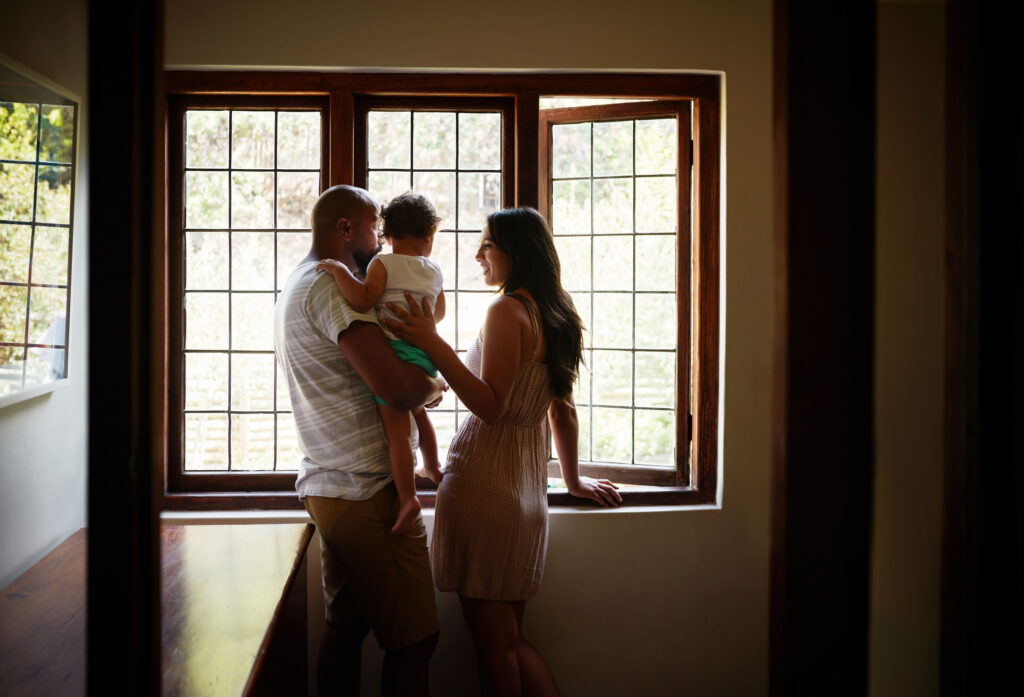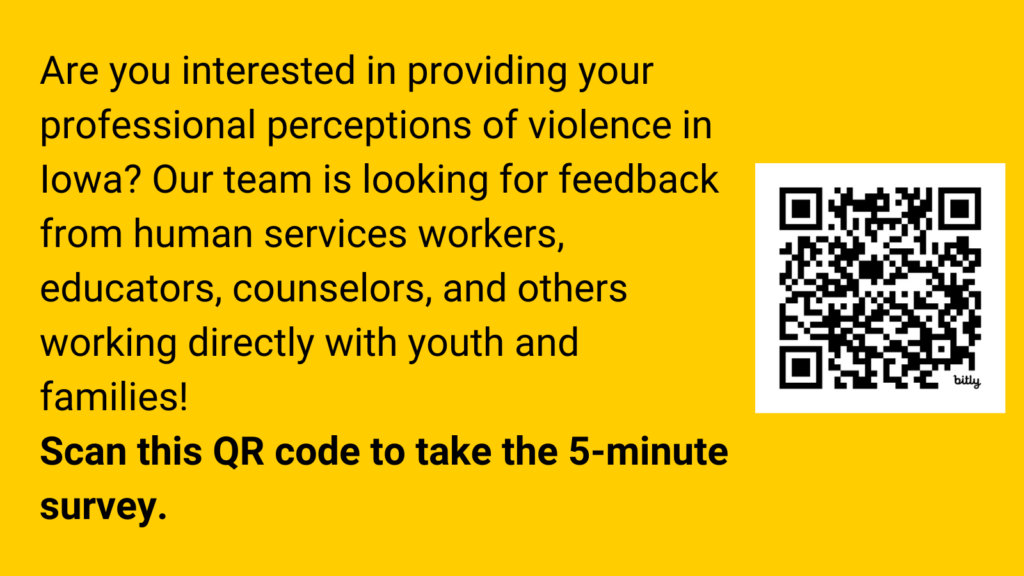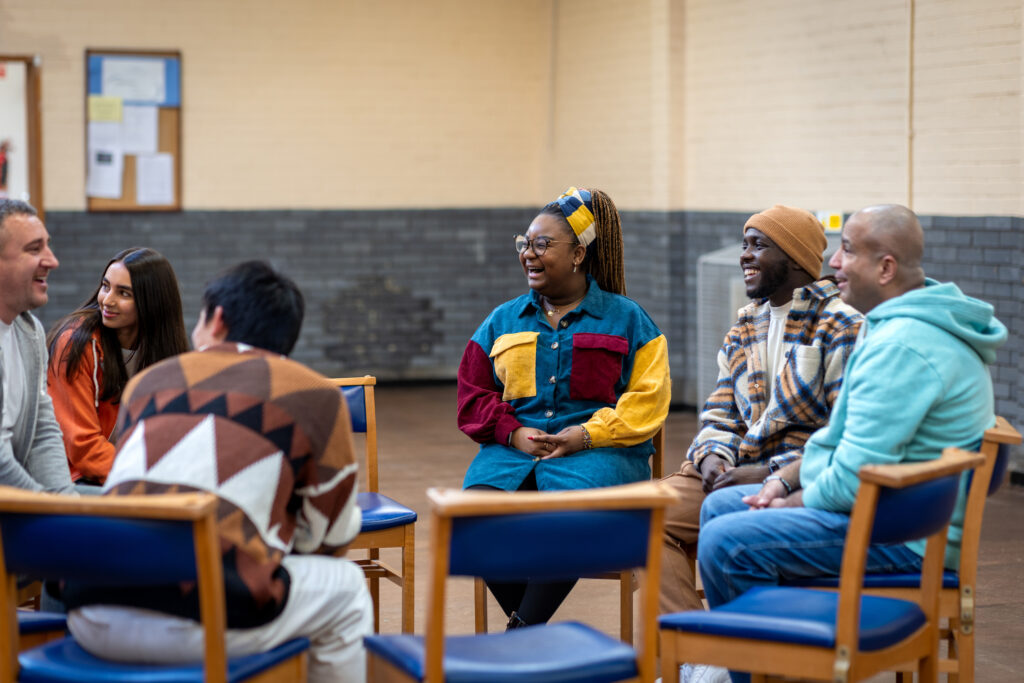Published on December 3, 2024
In communities, the scope and severity of violence – such as child abuse, elder abuse, intimate partner violence, bullying, sexual violence, and suicide – are often determined by how many cases are reported. However, a new state report offers insights about lived experiences, behaviors, and perceptions of these types of violence by discussing survey results of 620 Iowans, ages 18-65, about violence and safety.
These initial results show that Iowans overall feel safe from violence in their communities. For example, only youth violence was rated by more than 50% Iowans as a moderate or severe problem. Even so, many Iowan adults acknowledged knowing someone who has experienced violence or experienced violence themselves.
Monica Goedken is the violence prevention coordinator within the Division of Wellness and Preventive Health at the Iowa Department of Health and Human Services. She said that although adults residing in Iowa expressed that violence is a minimal problem within the state, almost 70% reported personally knowing someone who had been physically, emotionally, or verbally abused.
“Of that, 40% had been abused themselves. 40% is equivalent to two in five Iowa residents,” she said. These results indicate a high prevalence of violence exposure in Iowa. Meaning, violence is a problem in our state.”
The 2021 Statewide Survey of Safety and Violence in Iowa highlights the survey conducted through Iowa’s Rape Prevention Education program in partnership with the Iowa Coalition Against Sexual Assault (Iowa CASA), the University of Iowa and the University of Northern Iowa Center for Social and Behavioral Research.
Webinar: Perceptions of Community Safety in Iowa

Most Iowans said that they had not experienced several types of violence. Personal experiences specifically reported on were intimate partner violence (40.4%), non-consensual sexual activity (25.6%), and child abuse/neglect (20.8%).
Most also said that they knew someone who had been a victim of intimate partner violence (68.3%) or non-consensual sexual activity (54.9%). In addition, 48.9% reported that they knew someone who was abused or neglected as a child.
Goedken said that the report provides community members with information on where to start while identifying prevention activities. She said that it is challenging to collect quantitative data on the prevalence of violence within families and communities.
“Our prominent source of data is how many reported instances of violence were made to law enforcement, seen by victim-serving agencies, or disclosed in medical settings,” she said. “The quantitative numbers we do have are vastly underreported.”
There are valid reasons for underreporting, Goedken said, which are also tied to our coping skills, values, beliefs, and experiences.
“One is that those exposed to high rates of violence often don’t use formalized systems for reporting when they’ve experienced harm, abuse, or violence,” she said. “This is often because it is someone known to the victim (family, friend, dating partner, other known person to the family). Additionally, most first-time experiences with harm, abuse, and violence occur before the age of 18.”

The biggest concern: Youth bullying
Survey respondents indicated if they perceived a form of violence as not a problem, a small problem, a moderate problem, or a very big problem in their communities. Youth bullying was the highest concern (38% ‘a moderate problem’ and 19.5% ‘a big problem’) but was viewed as most likely preventable (>50% said it was mostly/ almost all preventable).
Child abuse/neglect and sexual violence were most viewed as ‘a small problem’ (36.3% and 36.8% respectively). Iowans perceived intimate partner violence nearly equally as ‘a small problem’ (32.7%) and ‘a moderate problem’ (33.9%). Similarly, suicide/ideation was viewed by 34.3% of Iowans as ‘a small problem’ and by 32.7% as ‘a moderate problem.’ Iowans perceived elder abuse/neglect as mostly ‘a small problem’ (40.9%).
Goedken said that our perceptions influence behaviors and help us understand what individuals and communities see as normal.
“It might be that since violence is so common, individuals may not perceive it as a problem because it has been socially normalized,” she said. “Additionally, community members may have developed coping skills around something that has always been in our dating relationships, peer groups, families, and communities.”
Overall, Iowans expressed concern over harmful events, rather than ignoring them. Most survey respondents said they would express concern if someone they knew was harmed but were less likely to intervene in cases of verbal harm/harassment than physical violence. 87.2% of Iowans were ‘very likely’ to help if someone they knew was having suicidal thoughts. 83.3% were ‘very likely’ to report suspected abuse or neglect of a child under age 18.

Parents talking to children about violence: What are they discussing?
Around 48% of Iowans who took the survey were parents or guardians of children under the age of 25. According to the report, parents were more likely to talk to their children about avoiding being a victim of violence than not being a perpetrator of violence.
On topics of sexual and dating violence, more parents reported discussing with their children how to protect themselves from physical, emotional, and verbal abuse (54%), sexual harm (72%), and non-consensual sexual activity (57%). However, fewer parents indicated having conversations about not causing physical, emotional, or verbal abuse (52.3%), sexual harm (47.9%), and non-consensual sexual activity (46.2%).
“This report helped us better understand how parents’ perceptions influence their conversations with their children and showed us that parents and other caring adults can focus on teaching skills to children and youth on how to not harm others,” Goedken said. “Also, we can model nonviolent problem-solving skills, provide opportunities for connections with nurturing pro-social peers, and economic supports for communities experiencing high unemployment, poverty, and low wages.”
Overall, parents were more likely to talk to their children about psychological or emotional bullying and using physical violence compared to sexual and dating violence.
Most parents said that they had spoken with their child about not engaging in psychological or emotional bullying (88.2%) and using physical violence (92.8%). About 87% of parents talked with their child about how to protect themselves from these types of violence.

Providing safe communities
When a community identifies a problem, Goedken said, it can ask meaningful questions to better understand the problem, identify the strategies and resources needed to improve it, and bring together diverse stakeholders to do something about it.
“Identifying a problem through data and ensuring communities perceive it to be a problem are two of the first steps in preventing or reducing the harm caused by that problem,” she said.
Goedken said various community activities have been shown to improve the health, safety, and well-being of Iowa residents while addressing the risk of harm, abuse, or violence to oneself and others.
Some example programs include:
- increasing cash assistance to single-parent households, connection to caring adults
- implementing workplace policies that support families
- high quality education
- early intervention to lessen harm
- home visiting programs
- mental health care for adult survivors of violence
- prioritizing affordable housing options
- high-quality childcare including free before and after school programs, social clubs, recreational activities, etc., for children and youth ages 8 – 17 while their caregiver is working
- microlending programs that prioritize Iowa residents ages 18 – 24
- working with concerned community groups to address the problems impacting poor health outcomes
Some resources:
- Webinar: Perceptions of Community Safety in Iowa
- IPRC brief: Preventing youth violence: What is the evidence?
- Safe Youth Collaborative
- National Sexual Violence Resource Center: What is an Askable Adult?
- CDC: Keeping children with disabilities safe
- The National Child Traumatic Stress Network: Understanding and Coping with Sexual Behavior Problems in Children: Information for Parents and Caregivers
- Iowa Coalition Against Sexual Assault
- Monsoon Asians and Pacific Islanders in Solidarity
- University of Northern Iowa Center for Social and Behavioral Research
- Prevent Child Abuse Iowa
- Eyes Open Iowa
- United Way of Central Iowa Safe & Thriving Youth – Youth Opportunities
- University of Northern Iowa Patricia A. Tomson Center for Violence Prevention
- Iowa Coalition Against Domestic Violence
- Iowa Attorney General’s Office Victim Assistance Section
- Criminal Juvenile Justice Planning
Are you interested in providing your professional perceptions of violence in Iowa? Our team is looking for feedback from human services workers, educators, counselors, and others working directly with youth and families! Take the 5-minute survey.